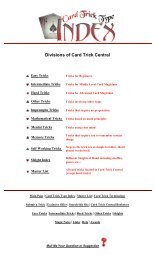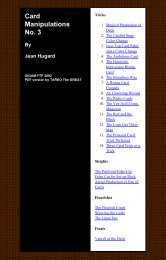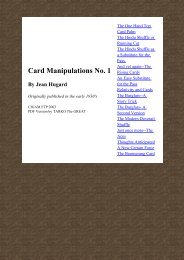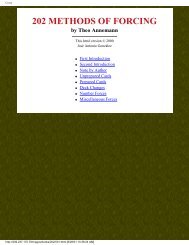The Encyclopedia of Card Tricks-Cover - Umclidet
The Encyclopedia of Card Tricks-Cover - Umclidet
The Encyclopedia of Card Tricks-Cover - Umclidet
Create successful ePaper yourself
Turn your PDF publications into a flip-book with our unique Google optimized e-Paper software.
Each <strong>of</strong> the four spectators taking part is given four cards from the<br />
top <strong>of</strong> the pack. <strong>The</strong>y are taken back in the same order as they<br />
were given out, and replaced at the bottom <strong>of</strong> the pack. A false<br />
shuffle may be introduced here, but the cards must be left intact<br />
at the bottom <strong>of</strong> the pack. Four whist hands are then dealt, and<br />
the process <strong>of</strong> the deal will distribute the sixteen bottom cards <strong>of</strong><br />
the pack to the tops <strong>of</strong> the four heaps and divide each original<br />
group <strong>of</strong> four cards among the same. So that directly the<br />
information is obtained that a chosen card is in a particular heap,<br />
as it can only be one card <strong>of</strong> that hasp, it is easily discovered. <strong>The</strong><br />
group <strong>of</strong> four cards last returned to the pack are the top cards <strong>of</strong><br />
the newly dealt hands, and when the last 'player' points out the<br />
heap that contains the card he thought <strong>of</strong>, it must be the top card.<br />
<strong>The</strong> four cards next returned are the second cards <strong>of</strong> the whist<br />
hands, and the second card <strong>of</strong> the hand that contains the thought<strong>of</strong><br />
card is it. And so on with the other two groups. It is essential to<br />
remember that the cards first returned to the pack are fourth after<br />
the deal, the second to be returned are third after the deal, the<br />
third the second, and the fourth the last.<br />
When performing this trick with an unprepared pack it is necessary<br />
for the performer either to look at the faces <strong>of</strong> the cards, or<br />
secretly glimpse the indices. With the pro-arranged pack this is<br />
unnecessary as he can name the cards by mental reference to the<br />
Code.<br />
He cannot, with the prepared pack, show the fourth hand without<br />
prematurely exposing the fact that it contains all <strong>of</strong> one suit, but<br />
this is not only unnecessary, but the omission adds somewhat to<br />
the effect. Any card or cards not revealed in the first three heaps<br />
must necessarily be in the fourth, and knowing this and being<br />
acquainted with the contents <strong>of</strong> the heap he can name them<br />
without any reference to it.<br />
Chapter Contents<br />
11. All Trumps<br />
'Now, gentlemen, if you please, we will play the hands out. Will<br />
you cut for trumps?<br />
'H's... <strong>The</strong>n I think the game is mine!'<br />
Procedure. This has already been explained at the beginning in the<br />
'Argument.' While astonishment over the last effect is still fresh,<br />
and the victims are not in a condition to notice the irregularity <strong>of</strong><br />
the proceeding, the performer picks up his own and <strong>of</strong>fers it for<br />
the cut. <strong>The</strong> other hands are pushed across to the would-be<br />
players, and after due interval they are confronted with the<br />
constellation <strong>of</strong> trumps.<br />
So far it is a smooth-working, rational sequence <strong>of</strong> effects. It may<br />
be extended or varied at discretion. <strong>The</strong> possibilities are not yet<br />
exhausted:<br />
Chapter Contents<br />
12. <strong>The</strong> Spelling Bee, 13. <strong>The</strong> Game Of Poker, and 14. <strong>The</strong><br />
Game Of 'Nap' have already been referred to. Here are some<br />
others,<br />
15. To Name <strong>The</strong> Position Of Any <strong>Card</strong><br />
Called For<br />
16. To Pick Out Any <strong>Card</strong> Called For<br />
Behind <strong>The</strong> Back<br />
This is merely a disguise <strong>of</strong> No. 15. All that is necessary is to note<br />
the bottom card, and follow the code while counting the cards<br />
behind the back until the required one is reached. If the pack has<br />
been disarranged it forms a suitable opportunity for an exchange<br />
<strong>of</strong> packs.<br />
Chapter Contents<br />
17. To Produce <strong>Card</strong>s Called For From<br />
<strong>The</strong> Pocket<br />
This, a feat usually achieved by the use <strong>of</strong> a duplicate pack sorted<br />
into the divisions <strong>of</strong> card holders, can be done with the stacked<br />
pack.<br />
Cut the 6D to the top, and divide the pack into four equal parts by<br />
riffling and sighting the indices. <strong>The</strong> first packet is cut at the<br />
thirteenth card, the 4D, and placed in the left breast pocket; the<br />
second is cut at the twenty-sixth card, the 4S, and placed in the<br />
right trousers pocket, the third is cut at the thirty-ninth card, the<br />
JC, and placed in the left trousers pocket; and the remaining<br />
thirteen cards are put in the right breast pocket. <strong>The</strong> backs <strong>of</strong> the<br />
cards in each case are outwards.<br />
When a card is called for, mentally refer to its Code number, from<br />
which it is clear which pack it is in; plunge both hands alternately<br />
into various pockets, and with the hand most convenient to the<br />
one containing the required card, count in accordance with the<br />
Code until it is reached, and bring it out <strong>of</strong> the pocket, together<br />
with all above it, and show as one, then return to the pocket. In<br />
this way the order <strong>of</strong> the cards is undisturbed.<br />
For instance, the KS is wanted. KS is the eleventh card, and<br />
therefore in the first division, and in the left-hand breast pocket.<br />
<strong>The</strong> right hand counts the cards, in this case conveniently<br />
backwards--thirteen, twelve, eleven: the thumb separates twelve<br />
from eleven and the rest, and these are gripped with thumb at one<br />
end, second and third fingers at the other end, and the first and<br />
fourth fingers one on each side, so that the cards are neatly and<br />
securely squared up.<br />
Again. <strong>The</strong> 3H is asked for. This is the forty-fourth card, and<br />
therefore in the fourth heap and in the right-hand breast pocket.<br />
Count from the top--forty, forty-one, forty-two, forty-three, fortyfour,<br />
and grip the five cards in the same way.<br />
<strong>The</strong> 6C would be thirty-one--in the left-hand trousers pocket. <strong>The</strong><br />
left hand counts, twenty-seven, twenty-eight, twenty-nine, thirty,<br />
thirty-one, and shows as before.<br />
At the conclusion, the packets are removed from the pockets in<br />
the reverse order to their insertion, and stacked one above the<br />
other to restore the order.<br />
Chapter Contents<br />
18. A Subtle Game<br />
Although the system is made use <strong>of</strong> in this trick, it is not<br />
necessary for the pack to be prearranged. To begin with it is<br />
therefore handed out for thorough shuffling. Prior to so doing,<br />
however, the performer abstracts, and palms, any four cards in<br />
Code order. For convenience we will assume the cards to be the<br />
four bottom cards <strong>of</strong> the stack--<br />
Three <strong>of</strong> Diamonds Five <strong>of</strong> Diamonds Queen <strong>of</strong> Diamonds Eight <strong>of</strong><br />
Hearts.<br />
After the pack has been shuffled to satisfaction, the palmed cards<br />
are returned to the top and subsequently forced upon four<br />
spectators.<br />
<strong>The</strong> four cards are returned and manipulated to the top <strong>of</strong> the<br />
pack by any <strong>of</strong> the usual processes. A false shuffle <strong>of</strong> any type that<br />
retains the four top cards is given. <strong>The</strong> cards are then dealt into<br />
four hands and one given to each <strong>of</strong> the four people who chose<br />
cards. <strong>The</strong>y are distributed in order so that each gets the hand<br />
containing his own card, and in gathering up, it is desirable to<br />
displace the bottom, so that the chosen card is not conspicuous.<br />
<strong>The</strong> parties are then instructed to sort their hands into suits, as for<br />
a game, and to hand the performer such cards as he calls for. On<br />
this amiable understanding, he proceeds to name the cards<br />
according to the Code backwards from the next in order to the<br />
four forced cards. In the present example therefore, he will first<br />
call for the 6H, then the 10D, next the 8C, and so on. As the cards<br />
are handed to him he places them naturally, face down, in the left<br />
hand. This he continues until one card only remains in each<br />
person's hand, that card being the one originally chosen. <strong>The</strong><br />
spectators are left with their chosen cards, and the wily wizard is<br />
left with--!<br />
I promised my reader that I should show him how to arrange the<br />
pack in full view <strong>of</strong> the audience, and I have now redeemed my<br />
promise. I have done more than I promised. He has not even had<br />
the trouble <strong>of</strong> arranging the pack. It is done, and the audience has<br />
done it for him lured into the belief that they are assisting a trick.<br />
<strong>The</strong> four isolated cards are taken in their proper order and added<br />
to the stack to complete the chain. If you can beat that for<br />
audacity--next please!<br />
This properly precedes the other tricks in order <strong>of</strong> execution but I<br />
have kept it till the last, partly so that it might come as a surprise<br />
and partly because familiarity with the material was necessary,<br />
both for its appreciation and for its performance.<br />
It may be used or not, by way <strong>of</strong> introduction, as circumstances<br />
demand, or, commencing with a previously arranged pack, it may<br />
be held in reserve against an accidental or antagonistic<br />
disarrangement.<br />
Chapter Contents<br />
[ Main Contents ] [ Next Chapter ] [ Previous Chapter ]








